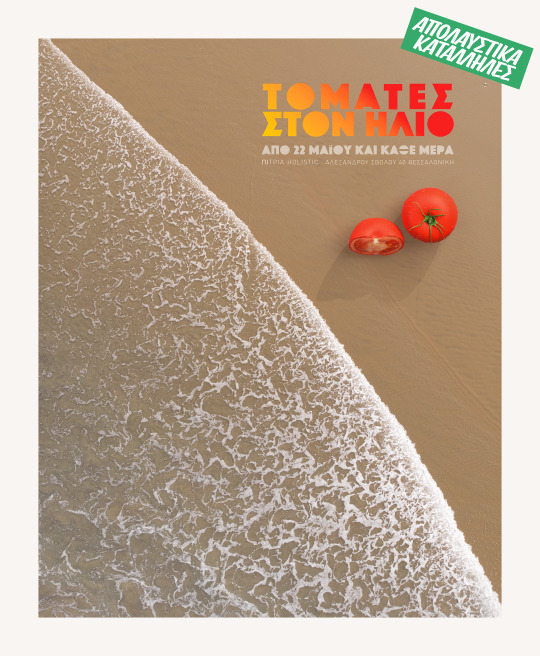#sustainable seeds
Text
How to Start a Medicinal Garden. CLICK HERE to get your own plan & seeds!
#gardening#seeds#sustainable seeds#ethical seeds#herbalism#herbs#medicinal herbs#medicinal plants#seed saving#sources#sustainable gardening#permaculture#solarpunk#self sufficient#self sufficiency#resilience#raised bed garden
1 note
·
View note
Text
"In response to last year’s record-breaking heat due to El Niño and impacts from climate change, Indigenous Zenù farmers in Colombia are trying to revive the cultivation of traditional climate-resilient seeds and agroecology systems.
One traditional farming system combines farming with fishing: locals fish during the rainy season when water levels are high, and farm during the dry season on the fertile soils left by the receding water.
Locals and ecologists say conflicts over land with surrounding plantation owners, cattle ranchers and mines are also worsening the impacts of the climate crisis.
To protect their land, the Zenù reserve, which is today surrounded by monoculture plantations, was in 2005 declared the first Colombian territory free from GMOs.
...
In the Zenù reserve, issues with the weather, climate or soil are spread by word of mouth between farmers, or on La Positiva 103.0, a community agroecology radio station. And what’s been on every farmer’s mind is last year’s record-breaking heat and droughts. Both of these were charged by the twin impacts of climate change and a newly developing El Niño, a naturally occurring warmer period that last occurred here in 2016, say climate scientists.
Experts from Colombia’s Institute of Hydrology, Meteorology and Environmental Studies say the impacts of El Niño will be felt in Colombia until April 2024, adding to farmers’ concerns. Other scientists forecast June to August may be even hotter than 2023, and the next five years could be the hottest on record. On Jan. 24, President Gustavo Petro said he will declare wildfires a natural disaster, following an increase in forest fires that scientists attribute to the effects of El Niño.
In the face of these changes, Zenù farmers are trying to revive traditional agricultural practices like ancestral seed conservation and a unique agroecology system.
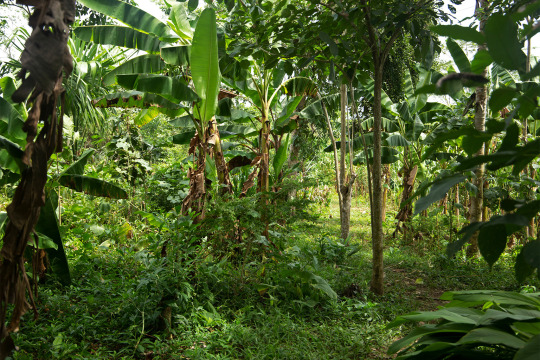
Pictured: Remberto Gil’s house is surrounded by an agroforestry system where turkeys and other animals graze under fruit trees such as maracuyá (Passiflora edulis), papaya (Carica papaya) and banana (Musa acuminata colla). Medicinal herbs like toronjil (Melissa officinalis) and tres bolas (Leonotis nepetifolia), and bushes like ají (Capsicum baccatum), yam and frijol diablito (beans) are part of the undergrowth. Image by Monica Pelliccia for Mongabay.
“Climate change is scary due to the possibility of food scarcity,” says Rodrigo Hernandez, a local authority with the Santa Isabel community. “Our ancestral seeds offer a solution as more resistant to climate change.”
Based on their experience, farmers say their ancestral seed varieties are more resistant to high temperatures compared to the imported varieties and cultivars they currently use. These ancestral varieties have adapted to the region’s ecosystem and require less water, they tell Mongabay. According to a report by local organization Grupo Semillas and development foundation SWISSAID, indigenous corn varieties like blaquito are more resistant to the heat, cariaco tolerates drought easily, and negrito is very resistant to high temperatures.
The Zenù diet still incorporates the traditional diversity of seeds, plant varieties and animals they consume, though they too are threatened by climate change: from fish recipes made from bocachico (Prochilodus magdalenae), and reptiles like the babilla or spectacled caiman (Caiman crocodilus), to different corn varieties to prepare arepas (cornmeal cakes), liquor, cheeses and soups.
“The most important challenge we have now is to save ancient species and involve new generations in ancestral practice,” says Sonia Rocha Marquez, a professor of social sciences at Sinù University in the city of Montería.
...[Despite] land scarcity, Negrete says communities are developing important projects to protect their traditional food systems. Farmers and seed custodians, like Gil, are working with the Association of Organic Agriculture and Livestock Producers (ASPROAL) and their Communitarian Seed House (Casa Comunitaria de Semillas Criollas y Nativas)...
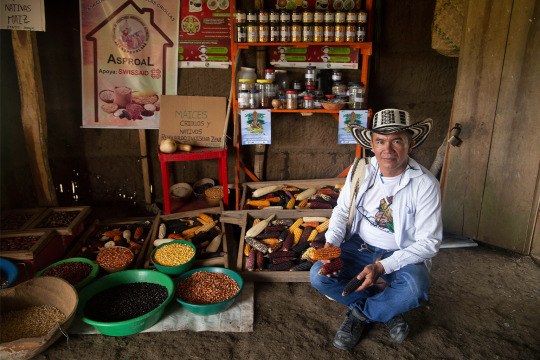
Pictured: Remberto Gil is a seed guardian and farmer who works at the Communitarian Seed House, where the ASPROL association stores 32 seeds of rare or almost extinct species. Image by Monica Pelliccia for Mongabay.
Located near Gil’s house, the seed bank hosts a rainbow of 12 corn varieties, from glistening black to blue to light pink to purple and even white. There are also jars of seeds for local varieties of beans, eggplants, pumpkins and aromatic herbs, some stored in refrigerators. All are ancient varieties shared between local families.
Outside the seed bank is a terrace where chickens and turkeys graze under an agroforestry system for farmers to emulate: local varieties of passion fruit, papaya and banana trees grow above bushes of ají peppers and beans. Traditional medicinal herbs like toronjil or lemon balm (Melissa officinalis) form part of the undergrowth.
Today, 25 families are involved in sharing, storing and commercializing the seeds of 32 rare or almost-extinct varieties.
“When I was a kid, my father brought me to the farm to participate in recovering the land,” says Nilvadys Arrieta, 56, a farmer member of ASPROAL. “Now, I still act with the same collective thinking that moves what we are doing.”
“Working together helps us to save, share more seeds, and sell at fair price [while] avoiding intermediaries and increasing families’ incomes,” Gil says. “Last year, we sold 8 million seeds to organic restaurants in Bogotà and Medellín.”
So far, the 80% of the farmers families living in the Zenù reserve participate in both the agroecology and seed revival projects, he adds."
-via Mongabay, February 6, 2024
#indigenous#ecology#agroforestry#agriculture#traditional food systems#traditional medicine#sustainable agriculture#zenu#indigenous peoples#farming#colombia#indigenous land#traditional knowledge#seeds#corn#sustainability#botany#plant biology#good news#hope#climate action#climate change#climate resilience#agroecology#food sovereignty
1K notes
·
View notes
Text
Hey y’all, if you’re a jewelry fan, the Native Seed Search website has dropped a jewelry update to help support their work: A Native American seed bank focused on the indigenous food of the American Southwest. Most of the jewelry for sale is silver and turquoise: a traditional art of the Diné (Navajo).
A selection of things for sale at the time of this post:
This sick gecko pin

These gorgeous dangle earrings
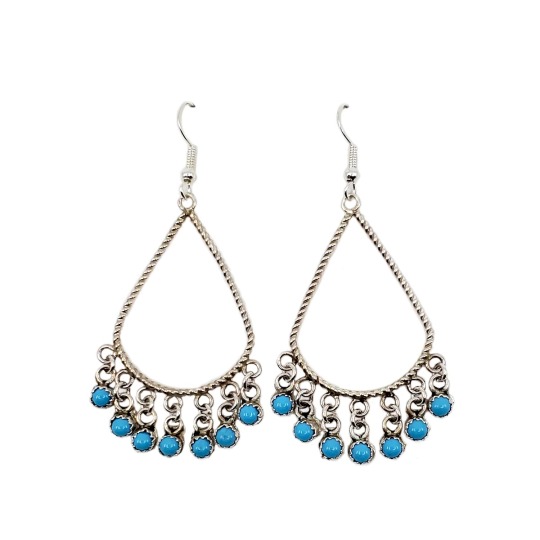
And these delicate feather earrings

Plus much more! I know none of us on this site have any money, but if you find any down the back of the couch, this is a great cause and some gorgeous wearable art.
(If you need international shipping, I would inquire with them directly, since I think their assumption is that most sales would be domestic.)
#indigenous art#native american#native american art#seed bank#conservation#biodiversity#sustainability#rocky rambles
1K notes
·
View notes
Text

Seed Bombs are little balls made up of a combination of compost, clay and seeds. The act of using the ball is called Seed bombing, which is the practice of introducing vegetation to land by throwing or dropping the seed bombs. The structure of the bomb enables the seeds to be launched over walls or distances, as the compost and clay act as a barrier to protect and nourish them, so they don’t need to be planted.
This technique is used by Guerrilla Garderners. Guerrilla Gardening is the act of gardening – raising food, plants, or flowers – on land that the gardeners do not have the legal rights to cultivate, such as abandoned sites, areas that are not being cared for, or private property.
223 notes
·
View notes
Text
This needs to become the norm!!!
1K notes
·
View notes
Text

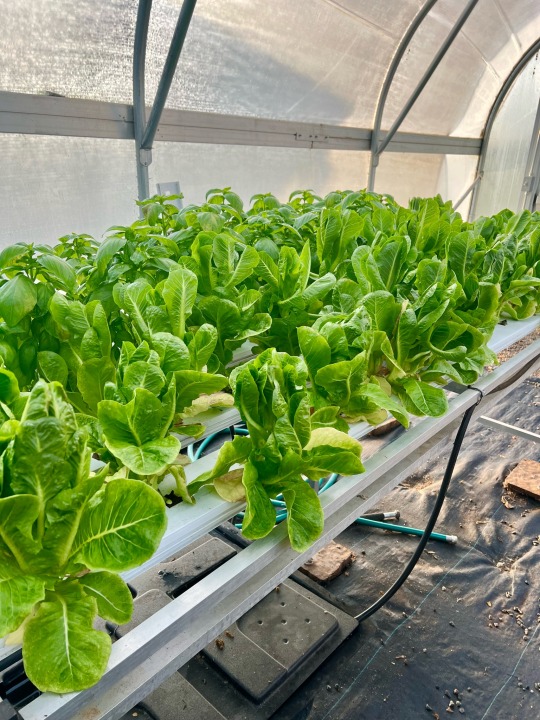
9/19/23 ~ Hydroponics at school. Those cucumbers grew super fast 😳 and some Romaine Lettuce!
#indoor garden#container gardening#sustainable gardening#vegetable gardening#starting seeds#grow organic#grow your own food#organic gardening#tomato garden#green witch#greenhouse#greenhouse nursery#plant nursery#hydroponics#growing cucumbers#romaine lettuce#sustainable agriculture
56 notes
·
View notes
Text
For those who are trying to find seeds
14 notes
·
View notes
Text


Seed-starting season is one of the best times of the whole year and that’s just the way it is
#flower farm#garden#flowers#sustainable#native plants#ecosystem#gardening#florist#flower seeds#jardin
3 notes
·
View notes
Text

It's that time!
I'm trying out peppers, both bell & paprika. Usually, our summers are too cool for them, but the last 3 have been quite hot, and it's supposed to switch to an El niño in August. So I am feeling pretty confident that we'll have another hot year, given NOAA's long term prediction for the summer months:
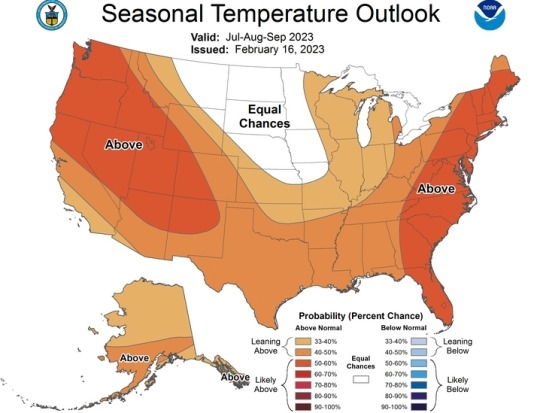
Note that that's a probability map, not temperature.
These guys are in my seed starting mix, which is about equal portions of homemade compost, coconut coir, and perlite, and they're growing indoors under lights. They'll stay inside until night time temperatures stay above 50f. When it's time to pot up, some of them will continue as is, and some will get soil mixed with the garden plot, to hopefully inoculate them with the native mycorrhizae, and some will get inoculated with store bought mycorrhizae. It'll be interesting to see what, if any, differences will appear.
#gardenblr#seed starting#sustainable gardening#because this is like#the 3rd round for those pots#and i got them out of a free pile#:D
21 notes
·
View notes
Text
Hello everyone!
A lil garden walk through and some updates :)
We'll start with the armenian cucumbers.

I'm hoping they'll pick up soon, but I may just need to do another direct seeding. A few sunflowers have self seeded and a carrot too,.
The patch I though was chamomile turned out to not be chamomile. Instead it turned out to be stinknet, it is considered an invasive weed here and has no current use to native species or humans (as far a si could find) so I pulled it and gave it to the chickens.
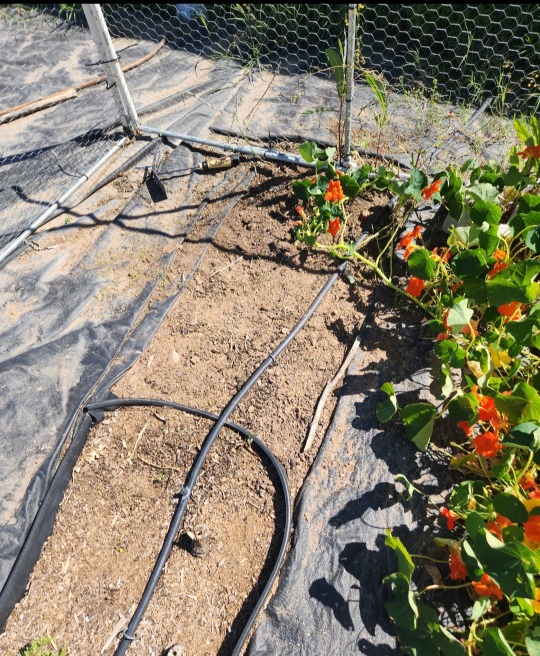
It looks very bare now 😭 I'll be building a small raised bed in this space and adding soil, once I've done that I intend to grow an edible herb of some sort here.
The nasturtium is doing really good,
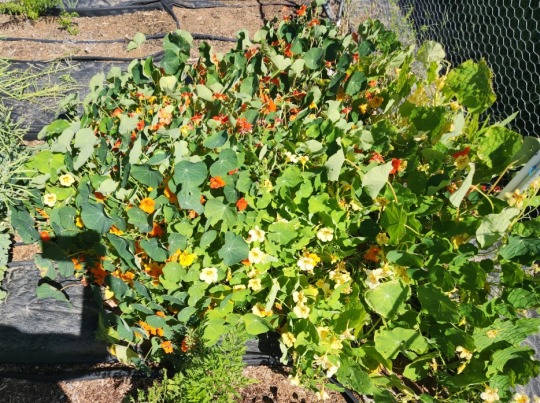
I intend to have another human and chicken harvest this week from them. They look a little wilty as it was warmer than it's been the last few weeks I also want to collect a small pint jar of the immature pods to try and turn into pickled capers :)
The broccoli are starting to get dried pods so I've been snagging them as I see the ripen or the birds start really cracking at them.

By the white arrow is the eggplants, which I believe I shall be pulling these ones and planting carrot seed here soon (after I trim down the seeding broccoli a bit)
The few carrot left arr still growing okay, but I think they are going to be spent very soon. Right now they've been more to keep ground cover around the tomatoes while they grow.
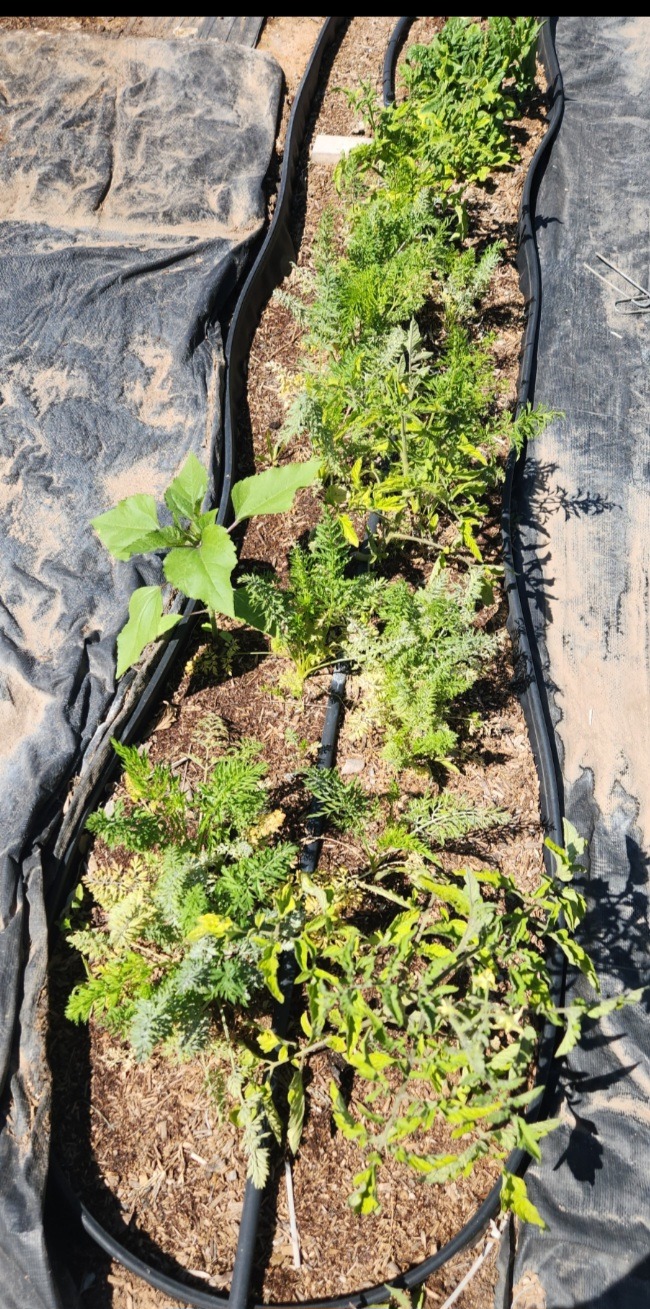
And a suprise sunflower sprouted among them, there is already flowers and even 1 tiny tomato!!!

An overview all of the current end row.
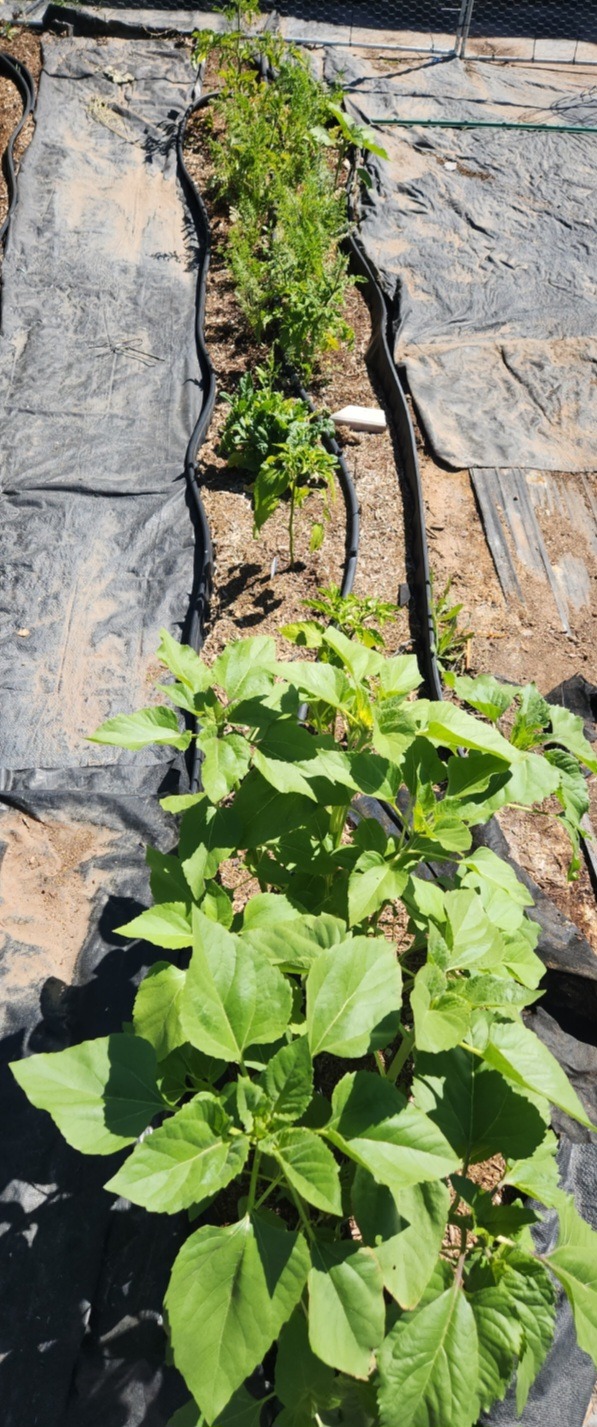
Sunflowers coming in too :)
And in exciting news~

We'll be working on extending the garden too. The tarps worked great to kill of the bad grass and keep it gone. I won't be digging the beds up for this one, instead I'll be doing a few raisedwooden beds.
That's it for now :)
🌱🌻Happy Homesteading and Urban gardening!🌻🌱
4.7 2024
#homesteading#self sufficient living#thestudentfarmer#studentfarmer#self sufficiency#food#garden#gardening#chickens#urban biodiversity#urban green spaces#urban homesteading#urban gardening#sustanance gardening#right to grow#grow what you eat#let it grow#sustainability journey#going green as can be#going to flower#going to seed#broccoli grow cycle#seed saving#carrot#eggplant#spinach#sunflowers#sunflower
5 notes
·
View notes
Text
Everyone's talking about chicken math but let's talk about plant math lol
For houseplants it's like, oh look at this little fern that's on sale for 5$! Wow! And then you bring it home, and it looks pretty, and isn't that spot on that windowsill just a little bare? And then you end up scrounging the clearance aisles months later and you already have twenty plants and where on earth is this one going to go? You don't know but you can't leave it there look how lonely it is!
For gardening plants in my experience it starts off with a normal garden the first year, then you buy a seed packet since it's cheaper than one three dollar start, and then you start like 50 tomato plants because that's whats in the packet but who cares about consequences you're having fun! 45 plants sprout and you're panicking trying to find people to take these plants. You end up with 25 left, you somehow find spots for all 25 tomato plants and you really only needed two but where's the rest of your starts going, specifically all those peppers and herbs? Who knows but by gosh you will find a space, you'll feel bad tossing any. Next thing you know you're yard/patio is a mini farm
#solarpunk#sustainable#environment#practical solarpunk#environmentalism#environmentally friendly#sustainability#ecofriendly#eco friendly#low waste#tomato gardening#indoor garden#garden#seedlings#seed starting#gardening
23 notes
·
View notes
Text
Unveiling the Desert's Charm: Growing Penstemons and Wildflowers in Queen Creek, Arizona
Transforming Arid Landscapes into Blossoming Gardens
In the heart of the Sonoran Desert, amidst the dry, rugged landscape of Queen Creek, Arizona, lies the potential for a blooming oasis. The key to this transformation? A brilliant array of penstemons and native wildflowers. This article will guide you through selecting the best penstemons for the low desert and companion wildflowers to create a…
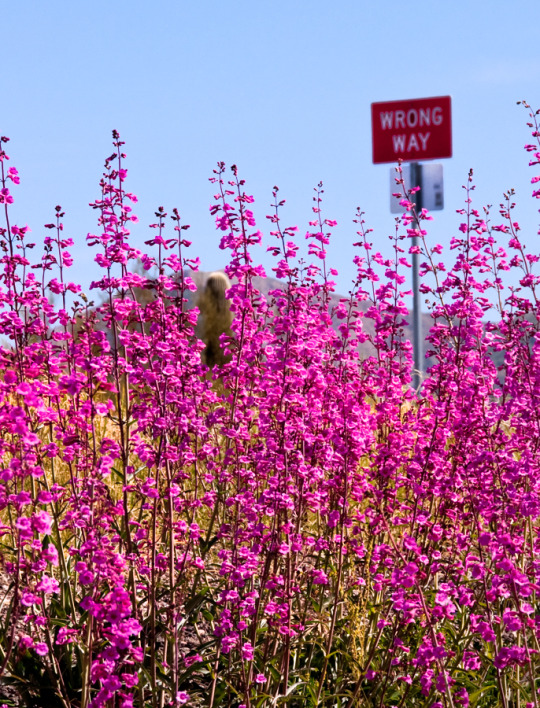
View On WordPress
#Desert Beardtongue#desert gardening#Desert Landscaping#Drought-Tolerant Plants#Eco-Friendly Gardening#Firecracker Penstemon#Garden Design#Growing Wildflowers#Hummingbird-Friendly Gardening#Native Plants#Penstemon Cultivation#Penstemon eatonii#Penstemon parryi#Penstemon pseudospectabilis#Pollinator Gardens#Queen Creek Arizona#Seed Germination#Sustainable Gardening#Xeriscaping
4 notes
·
View notes
Text
(Via: smokeyrgreens https://www.tiktok.com/t/ZTdWmgDUv/)
108 notes
·
View notes
Text

17 notes
·
View notes
Text

First growth of the year!
Few things are planted as early as February, but one of them are chilis. We've put some seeds by a sunny window upstairs, where they can grow without disturbance from curious cats or rowdy dogs. These are a couple of days old, and have been sprinkled with water every morning. We thought it'd be at least a week before we saw some green peaking out of the soil, so imagine our suprise when we found healthy leaves having made their way out already!
Since planting we've found a butterfly has been hibernating in the same window. We're feeding them with honeywater in hopes that it will soon be warm enough to let them back outside. It's really been a boost to see some life springing back into nature again, even if it's just indoors thus far. I hope for sunny spring days to come.
#Thesailorsgarden#cottagecore#rusticcore#cozycore#farmcore#grandmacore#countrycore#garden#cottage aesthetic#Gardening#Plants#Greenery#Vegetables#Farming#Agriculture#Sustainability#Planting#Seeds#Butterfly#Butterflies#Spring
15 notes
·
View notes
